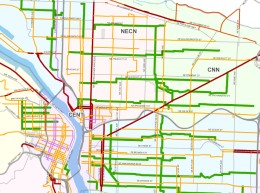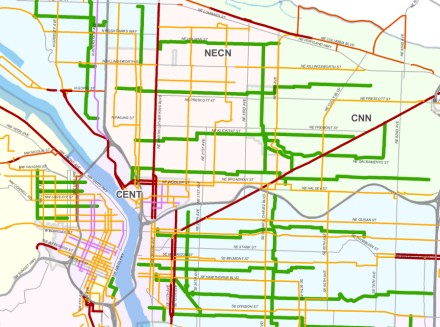
The Portland Bureau of Transportation has released an update on their 2012-2013 budget situation. As we suspected, a major shrinking of their budget has resulted in a restructuring of how the bureau will prioritize spending. In other big news, PBOT Director Tom Miller has unveiled a set of “organizational evolutions” that will change the face of the bureau.
As we’ve reported, PBOT faces a budget crisis of historic proportions. While all City bureaus are facing budget shortfalls, PBOT’s situation is especially bleak. Miller announced last month that he will reduce the agency’s General Transportation Revenue (GTR) budget by $16 million per year on an ongoing basis. When you consider that about $30 million of PBOT’s $100 million GTR budget is already committed, that’s a cut of about one-fifth of the total. In other words — an unprecedented contraction.
“I think the concept of [the Transportation] Options [Division] was probably provocative and compelling and progressive at the time of its inception; but I think it’s run its course. It’s time to re-invent that piece of the bureau. We will have an active transportation group within PBOT.”
— Tom Miller, Director of PBOT
Just to clarify, PBOT’s GTR budget is around $100 million (it was $107.5 million in FY 2011-12). Their total budget — which includes state and federal grants — is closer to $275 million. When we discuss this budget issue, we are only considering the GTR portion of the budget.
Last night at a meeting of the PBOT’s Budget Advisory Committee, Miller unveiled his plan to tackle the crisis.
In a message to the BAC, Miller wrote:
“When you have to cut as deeply as we do, you have to articulate priorities. In short, our approach is this: determine what the priorities are (e.g. functioning signals), where those priorities are most important (e.g. highest multimodal volume locations), and budget to maximize multimodal return on investment.”
To set the priorities, Miller is using a list of four criteria developed by the BAC (the committee also attached weighting to each criteria) and further refined by his own staff (download PDF of “Draft Budget Criteria”):
Each of the four criteria has been given a weight. Here’s the breakdown (note, the criteria is in draft form):
– Improves transportation safety (30%)
– Effective and efficient maintenance of Transportation’s assets (30%)
– Public health and livable communities (20%)
– Supports business and employment to promote economic vitality (20%)
Further refining the prioritization process, PBOT has assigned both a “substantive focus” and a “location focus” for each criterion. The substantive focus tells them how to spend the money and the location focus tells them where to spend the money.
With safety as a top priority, PBOT will first look to spend money on their “high crash corridors“. Also playing a prominent role in the location focus are what PBOT calls, “streets of citywide significance”. This is an important new term that will guide how PBOT prioritizes expenditures through the budget process for the foreseeable future.
Streets of citywide significance are defined as “streets that carry most of the multimodal volume”.

– Download PDF here –
“A dollar spent here [on a multimodal street], for example, would distribute limited resources more equitably than a dollar spent on a low volume, primarily single-use corridor,” reads Miller’s statement.
Put another way, Miller tells us, “The criteria tells us how the money will be spent, then the maps tell us where it goes.”
Sandy Boulevard is an example of a street that ranks very well under the new prioritization. Sandy is a major freight route, it carries frequent bus service, and it has a high volume of motor vehicles and people on foot.
What about bikes?
“For bikes,” Miller tells us, “we will treat the neighborhood greenway system as the streets of citywide significance.” While streets of citywide significance technically get first rank in priority, this new policy could actually make it more likely to see bikeway improvements on major arterials like Sandy. Here’s why: When you put spending through the priority “filters” of safety and multimodal transport, it’s possible that the formula favors adding bicycle access.
“It’s going to go through a series of filters to ensure we’re getting the dollars on the routes that are used by the most people in the city.”
— John Rist, PBOT business operations
Here’s a hypothetical: If PBOT had one dollar to spend, they’d take out 30 cents for safety. They’d prioritize reducing conflicts between modes (so a traffic signal — which is used by many modes — would score better, than say, a sidewalk repair project). Then, the first place they’d spend that 30 cents would be on a high crash corridor, after that they’d look to a street of citywide significance. The final filter would be vulnerable users, which they’ve listed out in priority order of: Safe routes to school, senior centers, community centers, and then neighborhood commercial districts.
John Rist, PBOT’s business operations manager says the new system gives them, “The ability to say to the public, as you work your way down of how you spend every dollar, it’s going to go through a series of filters to ensure we’re getting the dollars on the routes that are used by the most people in the city.”
One key reason Miller wants to adopt this methodology is to improve the transparency and public perception of how and where PBOT spends its money. “We’re trying to be specific so we can tell you, as a citizen, where that dollar goes and why it went there,” he said in a recent interview.

(Photo © J. Maus)
Miller — who took over as PBOT director less than one year ago — is also focused on a new push to make his agency more data-driven.
“We’re trying to be as data driven as possible… What we’re saying is, you apply the criteria that tells you how to spend the money than you look at the map and it tells you where to spend the money. You just work your way down the list and when you run out of money you’re done.”
This new approach is a major change from how PBOT has funded transportation in the past. It is much more specific and targeted to a given set of priorities; instead of being complaint driven and determined due to a process largely unknown to the public. PBOT has also adopted a four “guiding themes”: “equity; return on investment, minimum legal requirement, and revenue generation”.
In addition to the new budget priority process, Miller has announced a set of five significant structural changes to his organization. Below are the four initiatives he plans to advance:
1) A complete re-think of parking policy. Miller wants to consolidate all City parking functions under one roof. “Parking is an incredibly important piece of our revenue stream, but it’s managed in different parts of the agency… We need to speak with one voice.”
2) The Transportation Options Division (which promotes biking, walking, and taking transit and is behind popular programs like SmartTrips and Sunday Parkways) will be “re-invented”. Miller plans to create a new “active transportation group” that will be combined with PBOT’s planning functions. The goal, he says, is to “More explicitly call out the importance of the active transportation component of our mission and to make sure we are as focused there as we can be.”
Here’s more from Miller about the shifts coming to Options:
“I think the concept of Options was probably provocative and compelling and progressive at the time of its inception; but I think it’s run its course. It’s time to re-invent that piece of the bureau. We will have an active transportation group within PBOT.”
3) Improved asset management. This is part of Miller’s focus on data collection. An example he gives is tying priority of sidewalk repair with locations that see high transit boardings and de-boardings. “I want to know the condition of sidewalks that get people to and from those buses… With limited resources my sidewalks better be in best shape they can where boardings are highest… It’s about prioritization, and today, I can’t tell you that.”
4) PBOT will begin to monitor the condition of paint and thermoplastic that makes up much of the bikeway network. Miller says that unlike their ability to monitor pavement quality on major streets, PBOT has no system for tracking the condition of bike boxes, sharrows, or bike lane striping. “As a citizen, you ought to be able to know when we laid it [thermoplastic] down and when we need to refresh it. I can’t tell you that today. To me, that’s not appropriate.”
Miller sees bikeway thermoplastic and paint as a “hugely important” transportation asset. “A cyclist relies on that paint to provide a buffer between other modes. It says, this is my space, so stay out of it. If I’m not telling you how well we’re managing that asset I’m not doing my job as effectively as I need to.”
5) An outside review of PBOT business practices. Miller plans to hire a third-party company to take a look at PBOT’s internal processes and business practices.
This is a major announcement for Miller and by far the biggest step he’s taken since his tenure at PBOT began. He seems to be using the budget crisis as a way to enact some key reforms that he feels will not only address the funding shortfalls; but will also set a course for PBOT that will better serve his vision.
These initiatives, Miller feels, will also help the bureau overcome its current lack of public trust. Without the community on its side, Miller knows PBOT will be limited in its ability to go for the ultimate prize: a new, more stable and predictable source of ongoing revenue.
Mayor Adams has stated clearly that bureaus are not allowed to include new revenue sources in their budget plans; but that doesn’t mean Miller isn’t planning ahead. With dwindling gas tax revenues and a sluggish economy, it’s inevitable that PBOT will ask the public for new revenue. When they do, they’ll need as much trust as they can get.
Stay tuned for more coverage as the budget process unfolds.

